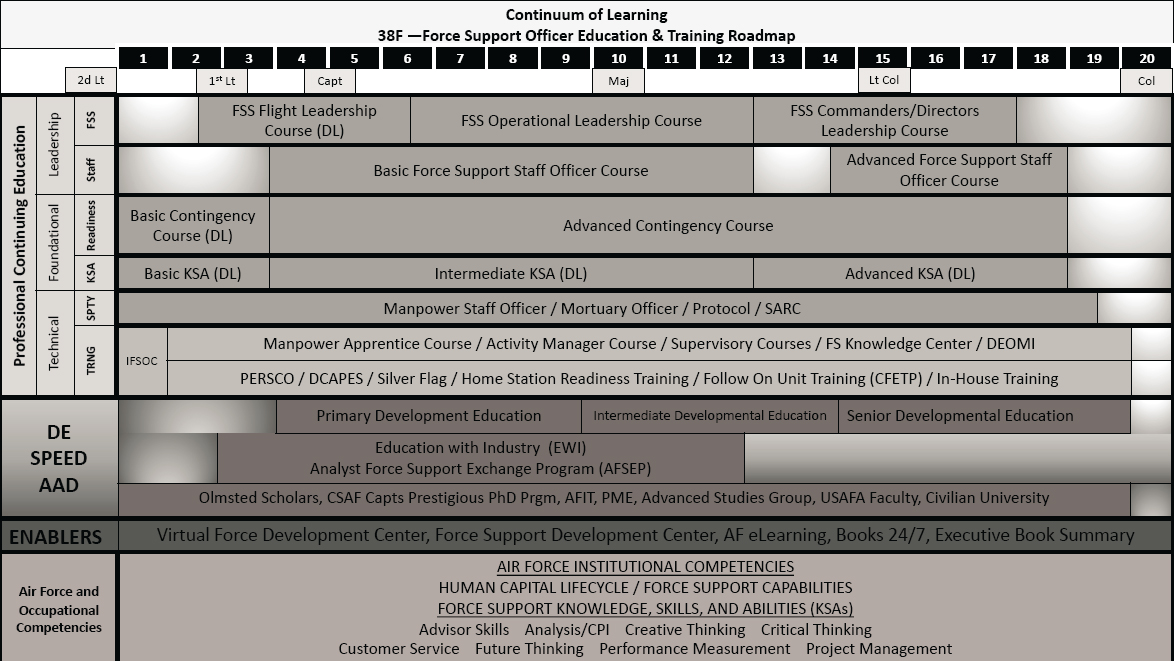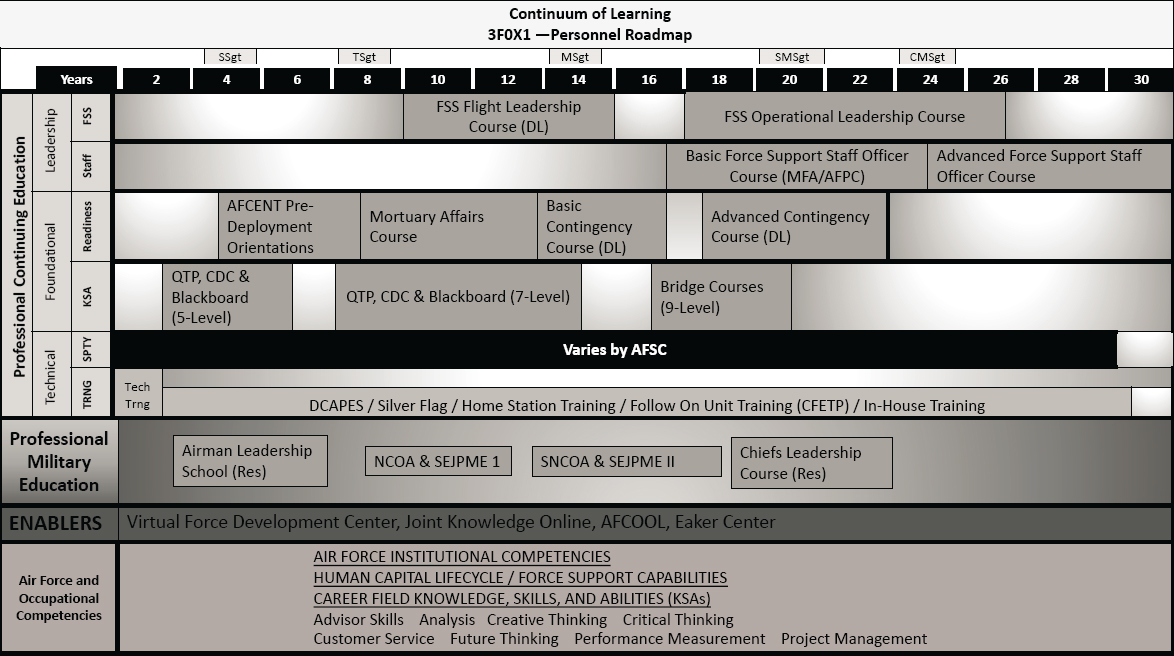Appendix F
Sample Career Field Education and Training Plans
The following pages are excerpted from two U.S. Air Force Career Field Education and Training Plans (CFETP) as samples representative of officer and enlisted CFETPs. The first is for Air Force Specialty Code (AFSC) 38FX, Force Support Officer. The second is for AFSC 3F0X1, Personnel, on the enlisted side. For each, CFETP general information (purpose) is provided along with figures describing the education and training roadmap for each CFETP (see Figures F-1 and F-2). Each roadmap identifies some of the competencies and opportunities for growing Airmen over their career. Specifics will vary between career fields and individuals, but the roadmap demonstrates that assignments should not be random and, rather, should progress through experiences that build upon each other leading toward targeted end states.
SAMPLE 1: AIR FORCE SPECIALTY CODE 38FX FORCE SUPPORT OFFICER1
General Information
Purpose.
The 38F [CFETP] provides a development strategy for the Career Field Manager, commanders, training managers, supervisors, and trainer to plan, develop, manage, and conduct 38F education and training. The
___________________
1 The material in this section was excerpted verbatim from Department of the Air Force (2018a, p. 8); for the purposes of this report, text placed in brackets have been inserted to clarify the original text.
outcome of this development strategy is to produce 38F leaders capable of delivering Force Support capabilities across the [Air Force] enterprise and Joint environment at the tactical, operational, and strategic levels. In sum, this plan outlines the purposeful execution of education, training, and experience opportunities to ensure successful development of 38Fs into strategic leaders of human capital assets.
Commanders and supervisors must take an active role in an officer’s professional development by providing mentoring and career planning. Officers should review career goals with their commander and supervisor or senior 38F during frequent mentoring sessions and performance feedback sessions. They should discuss career development and progression using the 38F Officer Education and Training Roadmap in Figure [F-1] and the 38F Experience Pyramid [in Figure G in the source but not included in this report].
Use.
All 38Fs will complete the leadership, foundational, and specialized education and training requirements in their appropriate stage of development or assignment as specified in this plan.
Coordination and Approval.
The Deputy Chief of Staff, Manpower, Personnel and Services is the approval authority for this plan. The Director, Force Support Professional Development School, Ira C. Eaker Center for Professional Development, Maxwell Air Force Base, AL, and the Commander, 335th Training Squadron, Keesler Air Force Base, MS, will identify and coordinate on the career field education and training requirements. The 38F Career Field Manager will initiate reviews of this document to ensure currency and accuracy.
Force Support Enduring Principles
For 38Fs to develop appropriately, they must understand the Talent Management Life Cycle; Combat Support Core Processes and Combat Support Capabilities; Force Support Capabilities; and Force Support Knowledge, Skills, and Abilities.
Introduction to Force Support Enduring Principles.
Force Support shapes the manner in which Airmen are postured, employed, sustained, and recovered in order to support the Air Force’s mission. It defines requirements, acquires and develops specific skills, postures them into an organizational and individual utilization strategy, sustains them from combat operations, and finally transitions them back to home station operations. Force Support provides unique capabilities for Combat Support. Force Support is, by design, not self-sustaining; it depends upon other Combat Support Capabilities for secu-
rity, health, and infrastructure support. Force Support is an integral part of the structure employed to open, establish, and operate air bases worldwide and subsequently redeploy forces to their home installations. It is an enabler by delivering agile, responsive, and efficient approaches to deliver combat Airmen to any theater or environment. In order to accomplish this mission set effectively, 38Fs must understand the Talent Management Life Cycle and Force Support Capabilities.

SOURCE: Adapted from Department of the Air Force, 2018a, Figure F, p. G-4.
NOTES: Acronyms: DL – Distance Learning; 2d LT – Second Lieutenant; 1st LT – First Lieutenant; Capt – Captain; Maj – Major; Lt Col – Lieutenant Colonel; Col – Colonel; FSS – Force Support Squadron; KSA – Knowledge, Skills, and Abilities; SARC – Sexual Assault Response Coordinator; FS – Force Support; DEOMI – Defense Equal Opportunity Management Institute; IFSOC – Initial Force Support Officer Course; PERSCO – Personnel in Support of Contingency Operations; DCAPES – Deliberate and Crisis Action Planning Execution Segments; CFETP – Career Field Education and Training Plan; DE – Developmental Education; SPEED – Special Experience Exchange Duties; AAD – Advanced Academic Degree; CSAF – Chief of Staff of the Air Force; AFIT – Air Force Institute of Technology; PME – Professional Military Education; USAFA – United States Air Force Academy; CPI – Continuous Process Improvement; TRNG – Training; SPTY – Specialty Training.
SAMPLE 2: AIR FORCE SPECIALTY CODE 3F0X1 PERSONNEL2
General Information
Purpose.
This CFETP provides the information necessary for Air Force Career Field Manager (AFCFM), [Major Command] Functional Advisors (MFA), commanders, training managers, supervisors and trainers to plan, develop, manage, and conduct an effective and efficient career field training program. The plan outlines the training that individuals in this [Air Force Specialty] should receive in order to develop and progress throughout their career. This plan identifies initial skills, upgrade, qualification, advanced, and proficiency training. Initial skills training is the Air Force Specialty specific training an individual receives upon entry into the Air Force or upon retraining into this specialty for award of the 3-skill level. Normally, this training is conducted by AETC at one of the technical training centers. Upgrade training is actual hands-on task performance training designed to qualify and airman in a specific duty position. This training program occurs both during and after the upgrade training process. It is designed to provide the performance skills and knowledge required to do the job. Advanced training is formal specialty training used for selected airmen. Proficiency training is additional training, either in-residence, exportable advanced training courses, or on-the-job training provided to personnel to increase their skills and knowledge beyond the minimum required for upgrade. The purpose of the CFETP includes:
- Serves as a management tool to plan, manage, conduct, and evaluate a career field training program. It is also used to help supervisors identify training at the appropriate points in an individual’s career.
- Identifies task and knowledge training requirements for each skill level in this specialty and recommends education and training throughout each phase of an individual’s career.
- Lists training courses available in the specialty, identifies sources of training, and the training delivery method.
- Identifies major resource constraints that impact full implementation of the desired career field training program.
Use of the CFETP.
Use of the guidance provided in this CFETP provides the foundation for effective and efficient training for individuals in this career
___________________
2 The material in this section was excerpted from Department of the Air Force (2018b, p. 8); for the purposes of this report, text placed in brackets have been inserted to clarify the original text.
field at the appropriate points in their careers. This plan enables the Air Force to train today’s workforce for tomorrow’s jobs.
AETC training personnel will develop or revise formal resident and non-resident, field and exportable training based on requirements established by the users and documented in Part II of the CFETP. They will also work with the AFCFM to develop acquisition strategies for obtaining resources needed to provide the identified training.
MFAs will ensure their training programs complement the CFETP mandatory initial, upgrade, and proficiency requirements. [On the job training], resident training, contract training, or exportable courseware can satisfy requirements. [Major Command] developed training to support this [Air Force Specialty] must be identified for inclusion in this plan.
Each individual will complete the mandatory training requirements specified in this plan. The lists of courses in Part II will be used as a reference to support training.

SOURCE: Adapted from Department of the Air Force, 2018b, p. G-9.
NOTES: DL – Distance Learning; TRNG – Training; SPTY – Specialty Training; SSgt – Staff Sergeant; TSgt – Technical Sergeant; MSgt – Master Sergeant; SMSgt – Senior Master Sergeant; CMSgt – Chief Master Sergeant; FSS – Force Support Squadron; MFA – Major Command Functional Advisors; AFPC – Air Force Personnel Center; AFCENT – U.S. Air Forces Central Command; QTP – Qualification Training Package; CDC – Career Development Course; AFSC – Air Force Specialty Code; DCAPES – Deliberate and Crisis Action Planning Execution Segments; CFETP – Career Field Education and Training Plan; Res – In-Residence; NCOA – Non-Commissioned Officer Academy; SEJPME – Senior Enlisted Joint Professional Military Education; SNCOA – Senior Non-Commissioned Officer Academy; AFCOOL – Air Force Credentialing Opportunities On Line; KSAs – Knowledge, Skills, and Abilities.
REFERENCES
Department of the Air Force. (2018a). Career Field Education and Training Plan 38FX, Parts I and II. Washington, DC: Headquarters of the Air Force. Available: https://static.e-publishing.af.mil/production/1/af_a1/publication/cfetp38fxc2/cfetp38fxc2.pdf.
Department of the Air Force. (2018b). Career Field Education and Training Plan 3F0X1. Washington, DC: Headquarters of the Air Force. Available: https://static.e-publishing.af.mil/production/1/af_a1/publication/cfetp3f0x1/cfetp3f0x1.pdf.










